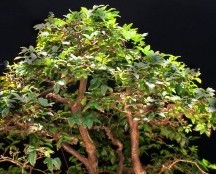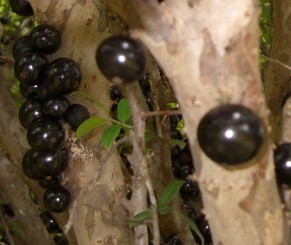
This evergreen tree is a relative of guava and true myrtle and a native of Brazil where it is grown for its fruit and sometimes known as Brazilian grape tree. The fruits and the flowers that produce them grow directly from the trunk and branches giving the tree a unique appearance especially when in fruit. The flowers are white with delicate petals and prominent stamens and are borne in clusters. The edible fruits are three quarters to one and half inches in diameter, grape-like, purple-black in color, and contain one to four seeds in a juicy, sour tasting pulp. The trunk is short, well branched with irregular limbs. The bark flakes off in large patches to produce an attractive pink, tan and gray mottled look similar to that of a crepe myrtle. The small, bright green leaves are oval and have a pink tinge when they first open. Although jaboticaba is considered evergreen it sheds half of the leaves each spring before new growth begins. The small size of the leaves, slow growth, and irregular growth pattern make jaboticaba a popular plant for bonsai. Its natural growth habit is most similar to the broom style but it can be grown in most styles. If you want flowers and fruits be forewarned; you may have to wait 10-15 years.


Position: Place plant in a light, partially shaded place such as a bright window. It can be kept indoors all year round but may be taken outside from mid-spring through summer and grown in a partially shaded location. In winter place in a room with temperatures between 61o and 75o F. and provide 50% humidity for best results.
 Water: Keep the soil slightly moist by watering generously in summer and less so in winter. Use water with a low mineral salt content such as rain water. If none is available, mix distilled water with an equal volume of tap water.
Water: Keep the soil slightly moist by watering generously in summer and less so in winter. Use water with a low mineral salt content such as rain water. If none is available, mix distilled water with an equal volume of tap water.
 Fertilizer: Apply an organic or liquid fertilizer every two to three weeks during the growing season, once a month in winter. Avoid strongly concentrated fertilizers.
Fertilizer: Apply an organic or liquid fertilizer every two to three weeks during the growing season, once a month in winter. Avoid strongly concentrated fertilizers.
 Repotting: Repot in spring every two years, accompanied by moderate root pruning.
Repotting: Repot in spring every two years, accompanied by moderate root pruning.
 Soil: Use a bonsai soil or mix of loam, peat moss, and sand at a ratio of 1:2:2
Soil: Use a bonsai soil or mix of loam, peat moss, and sand at a ratio of 1:2:2
 Pruning: Pruning can be done any time during the year but the best time is spring before new growth begins. Heavy upper branches should be avoided and trees can be cut back to old wood as new shoots will quickly appear. Once shoots have six to eight pairs of leaves they should be cut make to two to 4 pairs of leaves.
Pruning: Pruning can be done any time during the year but the best time is spring before new growth begins. Heavy upper branches should be avoided and trees can be cut back to old wood as new shoots will quickly appear. Once shoots have six to eight pairs of leaves they should be cut make to two to 4 pairs of leaves.
 Wiring: One to two year old branches can be wired in spring if necessary but the natural growth of the plant usually makes this unnecessary.
Wiring: One to two year old branches can be wired in spring if necessary but the natural growth of the plant usually makes this unnecessary.
 Propagation: Seed, removed from the fruit and planted immediately; cuttings from mid- to late summer.
Propagation: Seed, removed from the fruit and planted immediately; cuttings from mid- to late summer.
